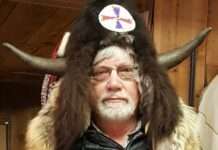The evening was far too hot and humid for the middle of April as I quietly walked across the alfalfa toward a tree line thick with fallen cottonwoods and old rotting hay bales. I followed the tree line until it ended abruptly, then tiptoed through a sea of Poison Ivy to the back door of our pop-up hunting blind. Once inside, I settled into a camp chair and unzipped windows on 3 sides. Approaching storms blew a nice breeze through the blind. In front of me was a narrow strip of alfalfa, hemmed in on the far side by wheat, and framed on 2 more sides by the river as it meandered through the countryside.
My quarries tonight were wild turkeys which I had seen here with some regularity, and I was prepared to shoot as many as possible. The flock I’d been seeing was perhaps a dozen birds, and I was pretty sure I could get them all with 2 shots at most! Three Blue Herons rose from the timber along the river, but were gone before I could shoot. A lone Red Tail Hawk perched high above the river was also giving me a nice shot if I hurried!
Now before you overload the switchboard at Operation Game Thief to turn me in to the authorities, allow me to explain. That night my weapon of choice hung by a strap around my neck; its barrel was a lense, and the trigger a small silver button. You guessed it! I was “shooting” photos with a camera
In the Kansas Hunter Education Manual, the chapter on Hunter Responsibility lists four stages of a sport hunter. This topic discusses how the standards by which a hunter defines success evolve and change as the hunter develops and matures. Stage 3 is called the “Trophy Stage,” and stage 4 is the “Method Stage.” During these 2 stages in a hunter’s life, he or she matures to the point where a trophy can just as easily be a photograph rather than a mount on the wall.
One frigid April morning years ago I shared a blind with a young man and his guide during the youth turkey hunt. That was before cell phones had such fantastic cameras, so I had a digital camera around my wrist, hoping to record some of the hunt in pictures. Among the group of birds that came to our decoys were several hens, and among them was a white-speckled hen. My camera wouldn’t work in the icy morning air, so I didn’t get a photo of her, and now I’m relegated to remembering her only in my mind, (which is quickly fading.) I was more disgusted over the camera malfunction than if I had missed a shot at a long bearded tom!
I started deer hunting when I was just a kid, and I wish I had pictures of every awesome and unusual event I’ve seen in the woods since. Once as I sat quietly on a log, a mother fox and several cubs ran by me so closely I could have reached out and grabbed one. While fishing one evening at McPherson State fishing lake I watched a beaver swim clear across the lake with a huge leafy branch in its mouth. Another time during the early January antlerless-only deer season, a buck with a monstrous rack hanging full of long grass and weeds stood just yards away from me. He looked like a hanging garden on four legs.
` I could go on, but my point is that all these things are in my mind’s eye only, and someday will probably be forgotten. If they were documented as photos, at least I could pass them on for others to enjoy as well. High dollar trail cameras are available that transmit photos directly to a computer, so why not a pair of glasses that does the same with images and action see through their lenses?
Not many years ago, if someone had suggested I could be as happy with a picture as with a mounted trophy on my wall, I would have bristled at the thought. Now, however, I feel like that transition will someday be an easy one… Continue to Explore Kansas Outdoors.
Steve can be contacted by email at [email protected].




